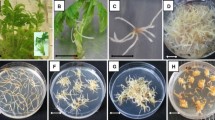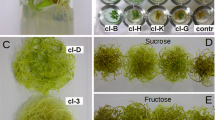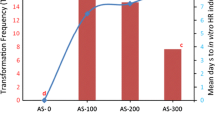Abstract
A thin, profusely branched, fast growing hairy root line of Panax quinquefolium (American ginseng) was established by co-culturing epicotyl explants with a wild type strain of Agrobacterium rhizogenes. The transformed roots grew by over 10-fold from the initial inoculum within 8 weeks. The crude ginsenosides content in the roots was about 0.2 g/g dry wt level up to the 10th week of culture. Ginsenosides Rb2, Rd, Re, Rf and Rg1 constituted 47–49% of the crude saponin fraction between 6 and 8 weeks of growth whereas, Rc ginsenoside was accumulated only after 9th weeks when the biomass started receding. PCR amplification analysis of the hairy roots confirmed their transgenic nature by showing the presence of Ri-TL DNA with rolA, rolB and rolC genes in their genome.


Similar content being viewed by others
References
Chen WP, Punja ZK (2002) Agrobacterium-mediated transformation of American ginseng with a rice chitinase gene. Plant Cell Rep 20:1039–1045
Gamborg OL, Miller RA, Ojima K (1968) Nutrient requirements of suspension cultures of soybean root cells. Exp Cell Res 50:151–158
Hooykaas PJJ, Klapwijk PM, Nuti MP (1977) Transfer of the Agrobacterium tumefaciens Ti plasmid to avirulent Agrobacterium and to ex planta. J Gen Appl Microbiol 98:477–484
Jeong CS, Murthy HN, Hahn EJ, Paek KY (2008) Improved production of ginsenosides in suspension cultures of ginseng by medium replenishment strategy. J Biosci Bioeng 105:288–291
Johanssen K (2006) Ginseng dreams: the secret world of America’s most valuable plant. The Univ Press of Kentucky, USA
Khanuja SPS, Shasany AK, Darokar MP, Kumar S (1999) Rapid isolation of DNA from dry and fresh samples of plants producing large amounts of secondary metabolites and essential oils. Plant Mol Biol Rep 17:1–7
Kim OT, Bang KH, Kim YC, Hyun DY, Kim MY, Cha SW (2009) Up-regulation of ginsenoside and gene expression related to triterpene biosynthesis in ginseng hairy root cultures elicited by methyl jasmonate. Plant Cell Tissue Org Cult 98:25–33
Krolicka A, Staniszwska I, Bielawski K, Malinski E, Szafranek J, Lojkowska E (2001) Establishment of hairy root cultures of Ammi majus. Plant Sci 160:259–264
Lal RK, Sharma JR, Misra HO (1997) Genetics of Senna (Cassia angustifolia Vahl.). J Herbs Spices Med Plants 5:3–10
Liang Y, Zhao S (2008) Progress in understanding of ginsenoside biosynthesis. Plant Biol 10:415–421
Mallol A, Cusidó RM, Palazón J, Bonfill M, Morales C, Piňol MT (2001) Ginsenoside production in different phenotypes of Panax ginseng transformed roots. Phytochemistry 57:365–371
Mathur A, Shukla YN, Pal M, Ahuja PS, Uniyal GC (1994) Saponin production in callus and cell suspension cultures of Panax quinquefolium. Phytochemistry 35:1221–1225
Mathur A, Mathur AK, Gangwar A (2000) Saponin production by cell/callus cultures of Panax species. In: Oleszek W, Marston A (eds) Saponins in food, foodstuffs and medicinal plants. Kluwer Academic Publishers, Dordrecht, pp 171–179
Mathur A, Mathur AK, Sangwan RS, Gangwar A, Uniyal GC (2003) Differential responses, ginsenoside metabolism and RAPD pattern of three Panax species. Genet Resour Crop Evol 50:245–252
Murashige T, Skoog F (1962) A revised medium for rapid growth and bioassays with tobacco tissue cultures. Physiol Plant 15:473–497
Nocerino E, Amato M, Izzo AA (2000) The aphrodisiac and adaptogenic properties of ginseng. Fitoterapia 71(Suppl 1):S1–S5
Tepfer D (1990) Genetic transformation using Agrobacterium rhizogenes. Physiol Plant 79:140–146
Washida D, Shimomura K, Nakajima Y, Takido M, Kitanaka S (1998) Ginsenosides in hairy roots of a Panax hybrid. Phytochemistry 49:2331–2335
Wu J, Zhong JJ (1999) Production of ginseng and its bioactive component in plant cell cultures: current technology and applied aspects. J Biotechnol 68:89–99
Yoshikawa T, Furuya T (1987) Saponin production by cultures of Panax ginseng transformed with Agrobacterium rhizogenes. Plant Cell Rep 6:449–453
Acknowledgments
Financial grant received from The Council of Scientific and Industrial Research (CSIR), New Delhi for carrying out this study is gratefully acknowledged.
Author information
Authors and Affiliations
Corresponding author
Rights and permissions
About this article
Cite this article
Mathur, A., Gangwar, A., Mathur, A.K. et al. Growth kinetics and ginsenosides production in transformed hairy roots of American ginseng—Panax quinquefolium L . Biotechnol Lett 32, 457–461 (2010). https://doi.org/10.1007/s10529-009-0158-3
Received:
Revised:
Accepted:
Published:
Issue Date:
DOI: https://doi.org/10.1007/s10529-009-0158-3




